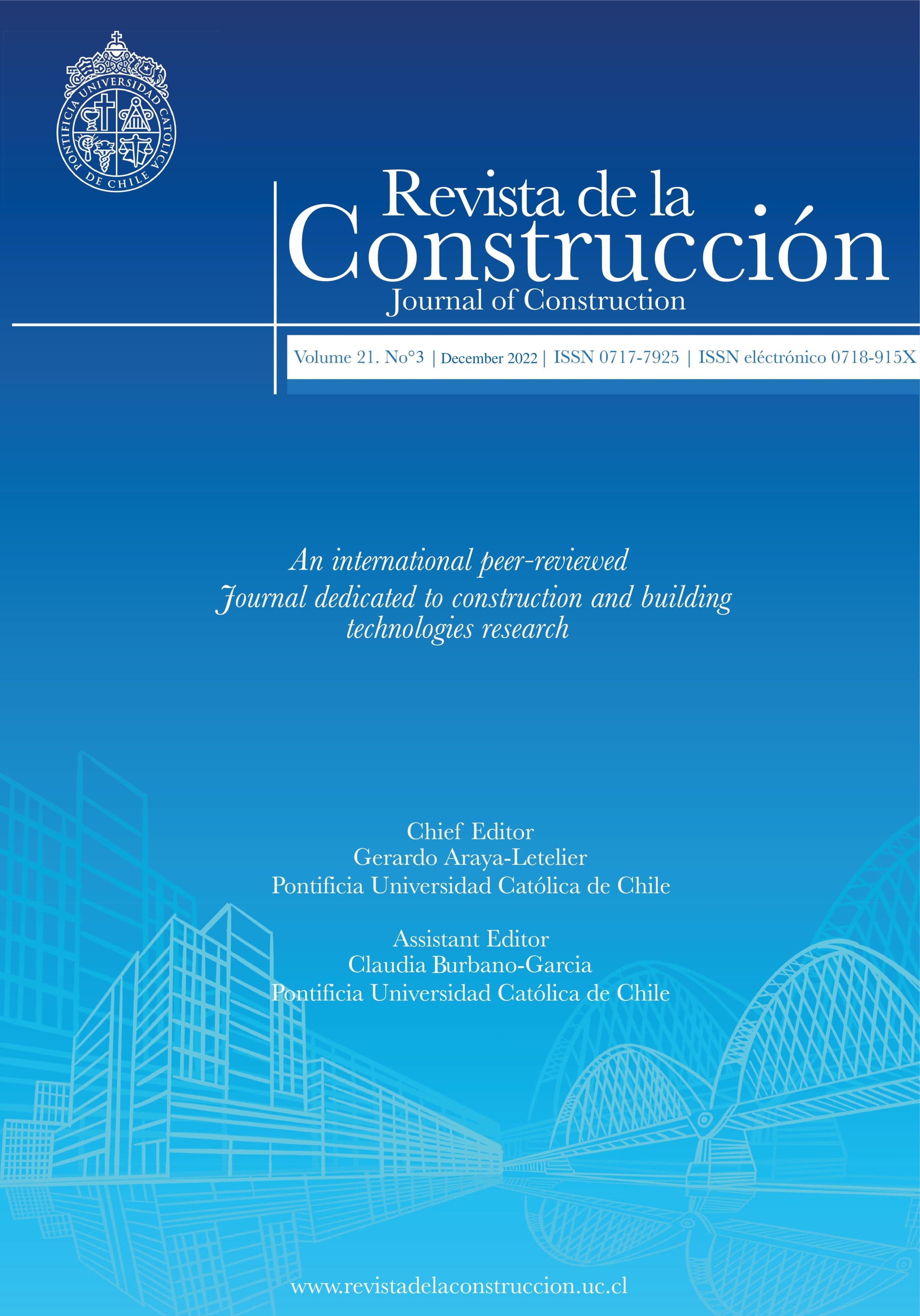Axial compressive behavior of short tie-columns with strapping spiral ties
DOI:
https://doi.org/10.7764/RDLC.21.3.657Keywords:
Spiral ties, strapping ties, tie-columns, experimental test, fracture energyAbstract
Spiral ties with rectangular cross sections have been developed as a new technology in construction, reducing the workforce in the reinforcement production series, because the worker does not have to place the tie reinforcement for the columns on the construction site. In this paper, a new type of tie was evaluated in short tie-columns subjected to axial compression to be applied in confined masonry. A comparison was made in this paper among spiral ties, with circular and rectangular cross sections, and traditional closed ties. The main aim of this research is to prove that these rectangular cross-section spiral ties can be used in tie columns for confined masonry structures. Twenty-one specimens were tested to investigate their structural behavior. As a part of the results, maximum loads, strains, load-displacement curves, and stress-strain relationships, were obtained based on testing standards, for both specimens and component materials. In addition, the fracture energy in compression and the ductility index were assessed. These results demonstrate that spiral ties with rectangular cross sections have an efficient structural response compared to traditional and circular spiral ties.
Downloads
References
Aceros-Titán-Company. (2016). Manufacture and Distribution of steel products for the Metal-Mechanical and Construction Industries. doi:https://www.acerostitan.com/certifications
ACI-318. (2019). Building code requirements for structural concrete: (ACI 318-14); and commentary (ACI 318R-14). In. Farmington Hills, MI: American Concrete Institute.
ACI-530. (2013). Building Code Requirements and Specification for Masonry Structures and Companion Commentaries. In TMS 602-13/4CI 530.1-13/ASCE 6-13 (pp. S-1-S-85).
ASTM-A370. Standard Test Methods and Definitions for Mechanical Testing of Steel Products. In.
ASTM-C39/C39M-18. Test Method for Compressive Strength of Cylindrical Concrete Specimens. In.
ASTM-C617/C617M-15. Standard Practice for Capping Cylindrical Concrete Specimens. In.
ASTM-E8/E8M-09. Standard test methods for tension testing of metallic materials. In A. A. State (Ed.).
Cai, G., Su, Q., Tsavdaridis, K. D., & Degée, H. (2018). Simplified Density Indexes of Walls and Tie-Columns for Confined Masonry Buildings in Seismic Zones. Journal of Earthquake Engineering, 1-23. doi:https://doi.org/10.1080/13632469.2018.1453396
Chai, T., & Draxler, R. R. (2014). Root mean square error (RMSE) or mean absolute error (MAE)? – Arguments against avoiding RMSE in the literature. Geosci. Model Dev., 7(3), 1247-1250. doi:https://doi.org/10.5194/gmd-7-1247-2014
Du, M., Jin, L., Du, X., & Li, D. (2017). Size effect tests of stocky reinforced concrete columns confined by stirrups. Structural Concrete, 18(3), 454-465. doi:https://doi.org/10.1002/suco.201600074
Gardner, L., & Yun, X. (2018). Description of stress-strain curves for cold-formed steels. Construction and Building Materials, 189, 527-538. doi:https://doi.org/10.1016/j.conbuildmat.2018.08.195
Grgić, N., Radnić, J., Matešan, D., & Banović, I. (2017). Stirrups effect on the behavior of concrete columns during an earthquake. Materialwissenschaft und Werkstofftechnik, 48(5), 406-419. doi:https://doi.org/10.1002/mawe.201700014
Gribniak, V., Rimkus, A., Torres, L., & Jakstaite, R. (2017). Deformation analysis of reinforced concrete ties: Representative geometry. Structural Concrete, 18(4), 634-647. doi:https://doi.org/10.1002/suco.201600105
Hong, K.-N., Han, S.-H., & Yi, S.-T. (2006). High-strength concrete columns confined by low-volumetric-ratio lateral ties. Engineering Structures, 28(9), 1346-1353. doi:https://doi.org/10.1016/j.engstruct.2006.01.010
JSCE. (2007). Standard specifications for concrete structures. In Desing (Vol. 15, pp. 503). Japan society of civil engineers Subcommittee on english version of standard specifications for concrete structures.
Li, W., Sun, L., Zhao, J., Lu, P., & Yang, F. (2018). Seismic performance of reinforced concrete columns confined with two layers of stirrups. The Structural Design of Tall and Special Buildings, 27(12), e1484. doi:https://doi.org/10.1002/tal.1484
Lizárraga, J. F., & Pérez-Gavilán, J. J. (2017). Parameter estimation for nonlinear analysis of multi-perforated concrete masonry walls. Construction and Building Materials, 141, 353-365. doi:https://doi.org/10.1016/j.conbuildmat.2017.03.008
Marques, R., & Lourenço, P. B. (2019). Structural behaviour and design rules of confined masonry walls: Review and proposals. Construction and Building Materials, 217, 137-155. doi:https://doi.org/10.1016/j.conbuildmat.2019.04.266
NTCM. (2017). Normas técnicas complementarias para el diseño y construcción de estructuras de mampostería. In (pp. 88).
Oller, S. (2001). Mechanical fracture: a global approach (in Spanish). Barcelona: Centro Internacional de Métodos Numéricos en Ingeniería, .
Salah-Eldin, A., Mohamed, H. M., & Benmokrane, B. (2019). Structural performance of high-strength-concrete columns reinforced with GFRP bars and ties subjected to eccentric loads. Engineering Structures, 185, 286-300. doi:https://doi.org/10.1016/j.engstruct.2019.01.143
Sun, L., & Li, W. (2019). Cyclic behavior of reinforced concrete columns confined with two layers of stirrups. Structural Concrete, 0(0). doi:https://doi.org/10.1002/suco.201800229
Tan, R., Eileraas, K., Opkvitne, O., Žirgulis, G., Hendriks, M. A. N., Geiker, M., . . . Kanstad, T. (2018). Experimental and theoretical investigation of crack width calculation methods for RC ties. Structural Concrete, 19(5), 1436-1447. doi:https://doi.org/10.1002/suco.201700237
Yun, X., & Gardner, L. (2017). Stress-strain curves for hot-rolled steels. Journal of Constructional Steel Research, 133, 36-46. doi:https://doi.org/10.1016/j.jcsr.2017.01.024
Zhao, Y., & Wang, F. (2015). Experimental studies on behavior of fully grouted reinforced-concrete masonry shear walls. Earthquake Engineering and Engineering Vibration, 14(4), 743-757. doi:10.1007/s11803-015-0030-5
Downloads
Published
How to Cite
Issue
Section
License
Copyright (c) 2022 Milena Mesa-Lavista , José Álvarez-Pérez, Jorge H Chávez-Gómez, Gerardo Fajardo San Miguel , Diego Cavazos de Lira, Fabián Ruvalcaba-Ayala

This work is licensed under a Creative Commons Attribution-NonCommercial-NoDerivatives 4.0 International License.








